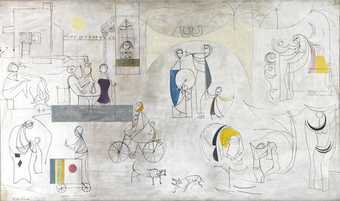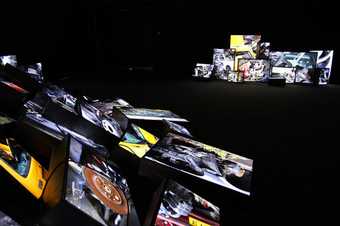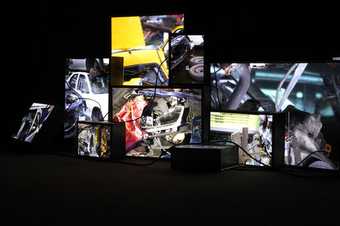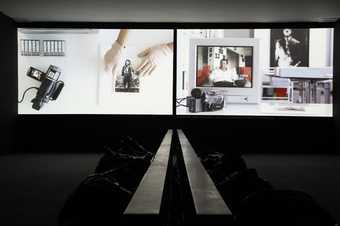“Nobody knows where Arab art began and where it stands today. It is one of the least studied areas in art.” So said Sheikh Hassan bin Mohammed bin Ali Al Thani, the founder of Mathaf: Arab Museum of Modern Art in Doha, at the inauguration of the museum in December. The Sheikh is bound to have his own view, having collected his 6000 or so works of modern and contemporary Arab art from over the last two decades, a selection of which appear in Mathaf’s first exhibition Sajjil: A Century of Modern Art.
Located in a former school building, recently re-designed by French architect Jean-Francois Bodin, the Mathaf’s debut show features works dating from the mid-nineteenth century to the present day. The aim is to give an overview of modern Arab art from a wide range of countries – and so included here are works by Egyptian artist Georges Sabbagh (1877–1951), the Iraqi Neziha Selim (1923–2008), Syrian painter Fateh al-Moudarres (1922–1999), the Palestinian painter Sliman Mansour (born 1947) and the Iraqi Dia Azzawi (born 1939).
Sajjil is the first exhibition of its kind – in terms of bringing together so many artists from the Arab world. The curators don’t claim Sajjil – quite rightly – to be the definitive guide to art from these regions, but suggests alternative narratives within the thematic strands of the exhibition. It may explain why they have used the title of the exhibition Sajjil - taken from a line of a poem by Mahmoud Darwish (1941–2008) the Palestinian poet and author who wrote the line ‘Sajjil ana Arabi’ (Record me, I am an Arab).

Taheya Halim
The Pyramid, the Civilization, Symbolism Through Ants c.1960s
Mixed media on board
233 x 237 x 237 cm
© Mathaf: Arab Museum of Modern Art
The works are both figurative and abstract – many mixing Western-influenced styles of painting mixed with Arabic imagery. Despite the geographical and cultural diversity of the artists on show, the curators have chosen to group the artists’ work by theme – nature, abstraction, family, the city – but the effect is to hide the disparate histories of art. This is part of the problem of such a collection, and one of the greatest challenges that future exhibitions should take on.
To non Arab audiences, many works that reflect Western styles – a bit of Renoir here, a bit of Picasso – will lead detractors to call some of these works ‘derivative’. However, as one of the writers in the catalogue points out, there is also the Arab art historical influence to take into account (as well as remembering that Western artists have borrowed from elsewhere).

Jewad Selim
Baghdadiat 1956
Mixed media on board
98.5 x 169 cm
© Mathaf: Arab Museum of Modern Art
For example, in the paintings of the artist Jewad Selim (a Turkish-born Iraqi artist who lived and worked in Iraq, and died in 1961) – the influence of Picasso is clear, but so too is the influence of Sumerian sculpture. While it is true that many of the artist in Sajjil were trained or spent some time in Western countries – often to return to their country of origin, however many moved to other Arab countries, including several of the artists in Sajjil who were part of Sheikh Hassan’s Qatar residency programme that operated during the period of sanctions on Iraq in the 1990s.
What is also not apparent in this exhibition is how centres of activity flourished in various Arab countries. Not surprisingly, these tended to coincide with more secular times in countries such as Iraq, Egypt and Lebanon. For example, the Egyptian Surrealist movement was led by artist George Henein after meeting Breton in Paris in the 1930s. Baghdad art flourished in the 1930s as did the Cairo art scene in the same decade. Later, in the late 1960s, Dia Azzawi set up the New Visions group in Baghdad before leaving for London. Similarly, Beirut was an important centre in the 1960s, and, apparently in 1970s Khartoum saw a notable period of performance. None of these interesting strands feature in Sajjil – though there are plans to explore the Egyptian Surrealist period.

Zined Sedira
Dead End 2010
Around sixty light boxes of variable sizes, and 2 video projections
© Mathaf: Arab Museum of Modern Art

Zined Sedira
Dead End 2010
Around sixty light boxes of variable sizes and 2 video projections
© All images Mathaf: Arab Museum of Modern Art
This exhibition was accompanied with two satellite exhibitions – Told / Untold / Retold, which features 23 commissioned works by contemporary Arab artists, as well as Interventions – works by five Arab artists whose work ‘crosses between modern and contemporary art’. Both housed in a temporary building (more like an exhibition hall) on the grounds of IM Pei’s glorious Museum of Islamic Art, these two complementary exhibitions acted as a counterpart to the historical collection.
The staging of Told / Untold / Retold was theatrically displayed – three separate sections that were meant to mirror the title of the show. This device wasn’t necessary, as the works worked better when considered individually. While the subtitle of the show was ‘23 stories of journeys through time and space’, the most persistent theme was inevitably the power of social and political context to inform and shape these artists’ works.
Could you, for example, watch Zineb Sedira’s two screen video End of the Road that included a car being slowly and systematically crushed, without thinking about the metaphorical implications. The young Syrian artist Buthayna Ali’s Y Why consisted of 22 cement slingshots, their elastic slings stretched back, each one reflecting according to their size ‘the ratio of forced immigration from the 22 Arab states’. Jerusalem-born Steve Sabella’s SETTLEMENT – Six Israelis and One Palestinian featured seven life size photographs of men in their underwear – six of whom stand in front of a wall that resembles the partition wall in Palestine, facing a photo of one man standing alone. (The artist chose this ratio in reference to the 1948 war that ended with a Jewish/Arab ratio of six to one within the former Palestininan territories.).
Despite the occasionally heavy-handed and explicit sentiment of these works, the underlying messages are hard to ignore. More subtle and engaging were the works that focused more on documentation and on the private stories. The paintings by Lebanese artist Jeffar Khaldi (born 1964) presented a personal history of his family, charting the life days from his father’s move from a refugee camp in the 1950s to Lebanon to the present day. Khaldi says his paintings of ‘washed out, pastel-like painted works is a humble and intimate tribute to my own family’s life in Lebanon in the 1960s’. In these images, there are many poignant stories within the stories, layer upon layers.

Akram Zaatari
On Photography, People and Modern Times 2010
Two-channel video projection and an installation of 15 single channel videos
© All images Mathaf: Arab Museum of Modern Art
In the same vein, Akram Zaatari’s installation On Photography, People and Modern Times celebrates the resonance of the universality of memory to invoke empathy. His installation of ten videos features 40 hours of footage from interviews that Zaatari did on a trip to various cities in the Arab world in the late 1990s. Zaatari, a Lebanese artist born in 1966, is the co-founder of the Arab Image Foundation which focuses on the collecting, studying and archiving the photographic history of the Middle East. It remains the most important repository of such information – and is growing fast. The stories that Zaatari has presented here and extraordinarily moving, and often surprisingly funny. One photographer tells a long story about a client who refuses to accept that the portrait he has taken of his sons is of them as the ‘ears are not right’, only to come back a few weeks and accept the photograph, even though the photographer has not changed anything. In another, the Lebanese collector Mohsen Yammine speaks poetically of how the reality of war, propelled him to save his country’s cultural heritage: ‘how every time a shell burst on a flower in the valley’ he would save another photograph of the past to ensure it was not lost forever.
As well as its ongoing exhibition programme, Mathaf has large plans to roll out an extensive education programme. They see it as a place ‘to understand connections, intersections and overlaps’ and will be granting research opportunities to explore these histories – in particular the ‘interdependent relationship of modernism and colonialism’. This may be why the curators chose the quotation from Darwish – a controversial figure in his day, but who was as much influenced by the Iraqi poet Badr Shakir al Sayyab as he was by Allen Ginsberg.
Their location might help too. Mathaf is situated in Doha’s Education City, some ten kilometres from the city centre, but surrounded by other academic institutions including Qatari outposts of Carnegie-Mellon University and Weill Cornell Medical College. The idea is, one imagines, that a campus environment of such neighbours could invigorate cross cultural and inter-displiplinary activity.
As well as these educational aims, Mathaf is currently amassing the disparate bibliographies of published works – academic and otherwise - on Arab modern art from across the world, with the aim of having Mathaf as the most important source for such material. It is a fabulous idea and what is extraordinary is that no such information currently exists in one place. It may well transpire that Doha will become far better known as a centre of art historical research than as a venue for the World Cup in 2022.
